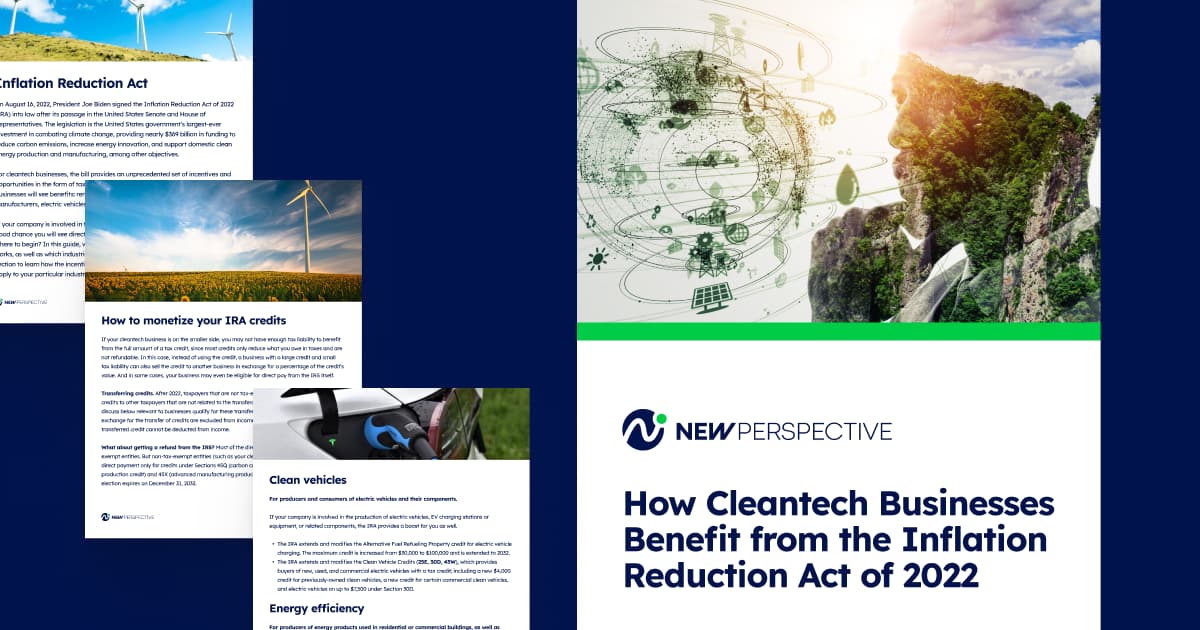Inflation Reduction Act: Benefits for Clean Energy Companies

On August 16, 2022, President Joe Biden signed the Inflation Reduction Act of 2022 (IRA) into law after its passage in the United States Senate and House of Representatives. The legislation is the United States government’s largest-ever investment in combating climate change, providing nearly $369 billion in funding to reduce carbon emissions, increase energy innovation, and support domestic clean energy production and manufacturing, among other objectives.
For cleantech businesses, the bill provides an unprecedented set of incentives and opportunities in the form of tax credits, loans, and grants. A wide range of green businesses will see benefits: renewable energy and clean fuel producers, manufacturers, electric vehicles, agritech, carbon capture and storage, and more.
If your company is involved in the cleantech space, even tangentially, there’s a good chance you will see direct benefits (and money!) thanks to the IRA. Not sure where to begin? In this guide, we break down how the tax credits system in the IRA works, as well as which industries it impacts and how. Feel free to read the first section to learn how the incentives work before scrolling down to find the ones that apply to your particular industry.
How IRA tax incentives work
The main incentives from the US government come in the form of tax credits, which are dollar for dollar reductions in a company’s tax liability in order to promote economic activity in a particular sector. Essentially, it’s free money from the government if you meet their guidelines.
If you’re in the clean energy industry, you’re most likely already familiar with the two main incentives for clean energy: the Production Tax Credit (PTC) and the Investment Tax Credit (ITC), which have been a part of the US Tax Code (Section 45 and Section 48, respectively) since the early 2000s. The Inflation Reduction Act both extends and revises the PTC and ITC, allowing more businesses to take advantage of them and for a longer time, while also creating some new credits (which we detail by industry in the section below).
PTC vs ITC
The PTC is a tax rebate given to producers of alternative and renewable energy on a per kilowatt-hour (kWh) basis for electricity generated by qualified energy sources. The idea is to help renewable energy production compete with petroleum and natural gas.
The ITC on the other hand, provides a direct tax rebate of a certain percentage of the investment in a qualified asset of business. Businesses and investors can take advantage of these credits by investing in assets that meet the requirements, such as solar, fuel cell, and wind technologies.
One key difference between the two is that the PTC continues to pay based on the amount of a product (in this case, renewable energy) produced, while the ITC requires an investment of actual dollars to be spent upfront to gain the one-time benefit of the credit.
The bonus rate opportunity
Most of the tax credits in the IRA, including the PTC and ITC, have two credit values: a lower base rate and a bonus rate. The bonus rate is up to five times (5x) the base amount, and cleantech businesses can receive this higher rate (and more tax savings!) by meeting additional requirements.
Most of these actions center around wage and apprenticeship requirements. But some credits can be increased if the activity occurs in certain low-income or former energy communities or, in the case of manufacturing, if they incorporate materials or products made in the US. The exact numbers around wages and apprenticeship will be provided in forthcoming guidance from the Department of the Treasury.
Here are the conditions to quality for a bonus rate:
- Pay prevailing wages. You must ensure that any laborers and mechanics are paid prevailing wages during the construction of a project and, during the relevant credit period, for the alteration and repair of such project.
- Provide apprenticeships. You must ensure that no less than the applicable percentage of total labor hours for the construction of the project is performed by qualified apprentices.
- Use domestic materials. You must certify that any steel, iron or manufactured product which is part of a facility was produced in the United States. For this purpose, manufactured products will be considered manufactured in the United States if the “adjusted percentage” of the total cost of the components of such product are mined, produced or manufactured in the United States.
- Build in an energy community. All PTC- and ITC-eligible projects are eligible for a 10% increase in credits if the project is built in an energy community, which the IRA defines as:
- A brownfield site as defined by the EPA
- A metropolitan or non-metropolitan statistical area with an above-average unemployment rate and either greater than 0.17% direct employment or greater than 25% local tax revenues related to coal, oil, or natural gas processes
- Census tracts containing mines that have closed after December 31, 1999, and any adjacent tract; or containing coal-fired generating units that were retired after December 31, 2009, and any adjacent tract
- Work with low-income communities. Applicable for solar and wind facilities, low-income communities are defined by 26 U.S.C.§ 45D(e) or on Indian land.
How to monetize your IRA credits
If your cleantech business is on the smaller side, you may not have enough tax liability to benefit from the full amount of a tax credit, since most credits only reduce what you owe in taxes and are not refundable. In this case, instead of using the credit, a business with a large credit and small tax liability can also sell the credit to another business in exchange for a percentage of the credit’s value. And in some cases, your business may even be eligible for direct pay from the IRS itself.
Transferring credits. After 2022, taxpayers that are not tax-exempt can transfer certain tax credits to other taxpayers that are not related to the transferor taxpayer. Most of the credits we discuss below relevant to businesses qualify for these transfers. Any payments received in exchange for the transfer of credits are excluded from income, and any amounts paid to obtain a transferred credit cannot be deducted from income.
What about getting a refund from the IRS? Most of the direct pay provisions only apply to tax-exempt entities. But non-tax-exempt entities (such as your cleantech business) are eligible for this direct payment only for credits under Sections 45Q (carbon capture credit), 45V (clean hydrogen production credit) and 45X (advanced manufacturing production credit) of the Code. This refund election expires on December 31, 2032.
In a hurry? Download a PDF version of this guide below

IRA tax credits: breakdown by cleantech industry
The Inflation Reduction Act is structured around key goals and industries which help in the process of decarbonizing the economy. Now that we understand how the tax incentives work, let’s look at who they work for within the cleantech space:
- which credits apply to which individual industry
- how long the credits last
- and how they’re expected to impact these industries.
We’ll also include which sections of the US Tax Code are impacted, so you can easily look up the original text yourself.
Energy generation
For producers of renewable energy, including solar, wind, geothermal, biomass, hydroelectric, and more:
For renewable energy products, the Section 45 PTC and Section 48 ITC discussed above are the main applicable incentives, and both of these are extended, expanded, and modified.
Until 2025
The PTC is extended until the end of 2024, after which it transitions to technology-neutral (which will still benefit renewable energy producers). For wind energy producers, the phasedown in place currently is removed as of Jan. 1, 2022, permitting wind projects to take the full value of the PTC through 2024.
The base credit will be 0.3 cents per kWh, with a bonus credit of 1.5 cents per kWh (credit multiplied by five) if prevailing wage and apprenticeship requirements are met (with an exception to these requirements for small projects). Taxpayers will be eligible for a bonus 10 percent PTC if certain domestic content requirements are met (adjusted percentage of generally 40 percent for most projects and 20 percent for offshore wind), or if the project is located in an energy community. If eligible for both, taxpayers can benefit from both of these percentage increases.
The IRA also extends the ITC until the end of 2024, as well as expanding what is eligible for the credit, including energy storage technology. For geothermal energy producers, the credit will be extended until 2035. The ITC base credit will be 6 percent, with a bonus credit of 30 percent (5x) if prevailing wage and apprenticeship requirements are met. Like the PTC, taxpayers will be eligible for an additional 10 percent ITC if certain domestic content requirements are met or if the project is located in an energy community.
For solar and wind energy producers, there is a potential 10 percent bonus credit for facilities located in low-income communities, and a potential 20 percent bonus for facilities that are part of a qualified low-income residential building project or a low-income economic benefit project.
After 2025
Beginning in 2025, the traditional ITC and PTC will generally no longer apply. They will be replaced by new technology-neutral credits which require that a facility’s greenhouse gas (GHG) emissions are no greater than zero. The credit amounts are the same as the current rate detailed above. These credits phase out in 2032 or when the Secretary of the Treasury determines that the annual GHG emissions are equal to or less than 25 percent of the emissions produced in 2022, whichever is earlier.
For nuclear power facilities
The IRA also creates a PTC for the production of electricity from a nuclear facility beginning in 2024. The base credit will also be 0.3 cents per kWh, with a bonus credit of 1.5 cents per kWh if the project meets prevailing and apprenticeship requirements, and expires after 2032.
Energy manufacturing
For manufacturers of renewable energy equipment, such as solar panels, wind turbines, hydroelectric and geothermal components, and more:
While the IRA has been celebrated for its support for renewable energy producers, it also provides powerful incentives for manufacturers of equipment and components used in clean energy production:
- The Section 48C Advanced Energy Project Credit, which provides incentives for manufacturers of a wide range of clean energy equipment, is extended and revised. The credit is expanded to include additional types of qualified investments for up to $10 billion in credits ($4 billion of which must be allocated to energy communities).
- The new Section 45X Advanced Manufacturing Tax Credit is for manufacturers of eligible components produced within the United States and sold to an unrelated party. Credits are available on an annual basis beginning in 2023, going through 2032 (with a phaseout beginning in 2030). Eligible components include components within wind, solar, and battery projects, such as PV cells, PV wafers, solar modules, blades, nacelles, inverters, and battery cells and modules, among many others. Credit rates vary depending on the component, with some rates depending on the cost of production and others based on certain capacity factors.
- The domestic content conditions in the PTC and ITC mentioned in the section above will provide incentive for renewable energy project developers to buy equipment manufactured in the United States.
Carbon capture and sequestration
For carbon capture and sequestration companies, as well as facilities implementing CCS technology:
The IRA makes the existing carbon capture tax credit significantly more accessible to a broad array of investors and developers, which will move carbon capture and storage (CCS) closer to realizing its potential as a critical decarbonization solution for hard-to-abate industries. Industrial sectors that previously lacked the incentives to decarbonize will now be more likely to embrace CCS technologies.
The IRA extends the Section 45Q carbon sequestration credit for facilities that begin construction before 2033, as well as provides additional modifications, including an enhanced credit for direct air capture (DAC) and lowering the carbon capture threshold requirements at facilities.
- The IRA increases credit values across the board, including increases from:
- $50 to $85/tonne for storage in saline geologic formations from carbon capture on industrial and power generation facilities
- $35 to $60/tonne for utilization from industrial and power generation carbon capture
- $50 to $180/tonne for storage in saline geologic formations from DAC
- The IRA extends the commence construction window for qualifying projects seven years (until January 1, 2033).
- The IRA gives a direct pay option for the credit (for the first five years) and extends the transferability.
- The IRA will lower the annual thresholds of carbon a facility must capture to qualify:
- 18,750 tons of carbon oxide for power plants
- 12,500 tons of carbon oxide for industrial facilities, and
- 1,000 tons of carbon oxide for DAC facilities.
Clean fuels
For producers and consumers of alternative and renewable fuels such as clean hydrogen, biodiesel, and more.
Producers of renewable fuel sources will also see their tax credits expand through the end of 2027, with an extension and expansion of current credits through 2024 and the creation of the new Clean Fuel Production Credit. Clean hydrogen producers will also have access to a new tax credit.
- Clean hydrogen. The IRA creates an ITC and a PTC for clean hydrogen (can be either green hydrogen or blue hydrogen).
- Hydrogen must be produced through a process resulting in lifetime GHG emissions of no more than 4 kgs of CO2e per kg of hydrogen. The base credit amount will be 60 cents per kilogram of qualified clean hydrogen, multiplied by an emissions factor depending on the GHG emissions factor provided by the fuel.
- Sustainable aviation fuel. A new limited-time refundable income and excise tax credit of up to $1.75 per gallon for the sale and mixture of sustainable aviation fuel for 2023 and 2024.
- Biodiesel and renewable fuels. The IRA will extend the existing biodiesel, renewable diesel, alternative fuels, alternative fuels mixtures and second generation fuels tax credits (Sections 40A, 6426, and 6427) through 2024.
Clean Fuel Production Credit
Starting Dec. 31, 2024, existing fuel credits will transition to the Clean Fuel Production Credit, which expires at the end of 2027. This credit is for producers and sellers of clean transportation fuel.
In order to receive the full credit the fuel must have a life-cycle emission level of less than 50 kilograms of CO2e per mmBTU. Credit-per-gallon base amounts are $0.20 (non-aviation fuel) and $0.35 (aviation fuel), with respective increases in credit amount to $1.00 per gallon (non-aviation fuel) and $1.75 per gallon (aviation fuel) if the wage and apprenticeship requirements are met. The base credit is adjusted downward based on the emission factor of the fuel, and the lower a fuel’s carbon intensity score, the higher the potential credit.
Clean vehicles
For producers and consumers of electric vehicles and their components.
If your company is involved in the production of electric vehicles, EV charging stations or equipment, or related components, the IRA provides a boost for you as well.
- The IRA extends and modifies the Alternative Fuel Refueling Property credit for electric vehicle charging. The maximum credit is increased from $30,000 to $100,000 and is extended to 2032.
- The IRA extends and modifies the Clean Vehicle Credits (25E, 30D, 45W), which provides buyers of new, used, and commercial electric vehicles with a tax credit; including a new $4,000 credit for previously-owned clean vehicles, a new credit for certain commercial clean vehicles, and electric vehicles on up to $7,500 under Section 30D.
Energy efficiency
For producers of energy products used in residential or commercial buildings, as well as businesses retrofitting their properties for energy efficiency.
The IRA’s energy efficiency credits can apply to a wide range of cleantech businesses. The qualified energy property made eligible for the credit covers a wide range of products, including batteries, water heaters, heat pumps, central air conditioners, hot water boilers, biomass stoves, oil furnaces, air sealing materials and systems, costs of home energy audits, and electrical panels installed to enable qualified improvements, so if you think your business produces something that may qualify, be sure to check!
- Residential:
- Beginning in 2022, the IRA will modify, expand and extend the nonbusiness energy property credit (Section 25C) through 2032 by increasing the credit from 10 percent to 30 percent.
- The lifetime cap on the credit is replaced with a $1,200 annual credit limitation, except in the case of heat pumps and biomass stoves, for which the credit may be up to $2,000.
- The IRA will extend through 2034 the Section 25D credit, which allows taxpayers to claim a credit for qualified residential energy efficient property purchases.
- The IRA will extend through 2032 and increase the value of the residential energy efficient property credits (45L) providing contractors with tax credits for housing units built or remodeled to reach energy-saving specifications for a variety of home types.
- Commercial:
- Beginning in 2023, the IRA will modify, expand and extend the energy efficient commercial buildings deduction (179D).
Agriculture and forestry
For agri-tech businesses and renewable energy providers selling to rural communities and farmers
For businesses involved in agri-tech, forestry management or water conservation technologies, or who provide renewable energy to rural communities, the IRA may impact you as well.
The IRA gives the US Department of Agriculture nearly $14 billion to support rural electric cooperatives purchasing renewables; more than $20 billion for climate-smart agriculture practices; $5 billion in grants for healthy forests, forest conservation, and tree planting; and $2.6 billion in grants to restore and conserve coastal habitats and protect nearby communities.
Learn more about Agriculture Commission Provisions in the IRA here.
More IRA incentives for cleantech
While tax credits provide the bulk of incentives for cleantech businesses in the IRA, the potential benefits don’t stop there. While tax credits can provide direct help to the balance sheet of your business, consider how your customers will benefit from these incentives and incorporate that information into your sales process. For cleantech businesses who sell to government clients such as municipalities, counties, or federal agencies, many of these potential customers will have access to new grants that support their transition to renewable energy sources and electrification.
The Act also provides a range of new financing opportunities cleantech firms and their customers can tap into when looking to invest in new projects, such as:
- New Loan Programs Office (LPO) financing from the Department of Energy such as the “Energy Infrastructure Reinvestment” program, which provides loan guarantees for renewable energy and emission reduction projects.
- The Greenhouse Gas Reduction Fund, which provides investment in state, local, and nonprofit financial institutions to fund private sector low- and zero-emission technology projects
- The IRA will provide $5.812 billion to create a new program within the Office of Clean Energy Demonstrations (OCED) to invest in projects aimed at reducing emissions from energy intensive industries. The program will provide financial assistance for domestic, non-federal, non-power industrial or manufacturing facilities to “purchase, install or implement advanced industrial technology or retrofit, upgrade or operationalize improvements to install or implement advanced industrial technology.”
Ready to seize the cleantech opportunity and find new customers?
With the new incentives created by the Inflation Reduction Act, the future for the cleantech industry (and the Earth) are looking brighter than ever. Cleantech companies have an enormous opportunity this decade to help decarbonize the economy, from energy production to manufacturing to vehicles and homes.
Are you ready to grow your cleantech business in 2023? We can show you how. At New Perspective, we’re proud to work with the companies creating a better future for us all. Reach out to schedule a conversation with one of our cleantech marketing experts.
In a hurry? Download a PDF version of this guide below




